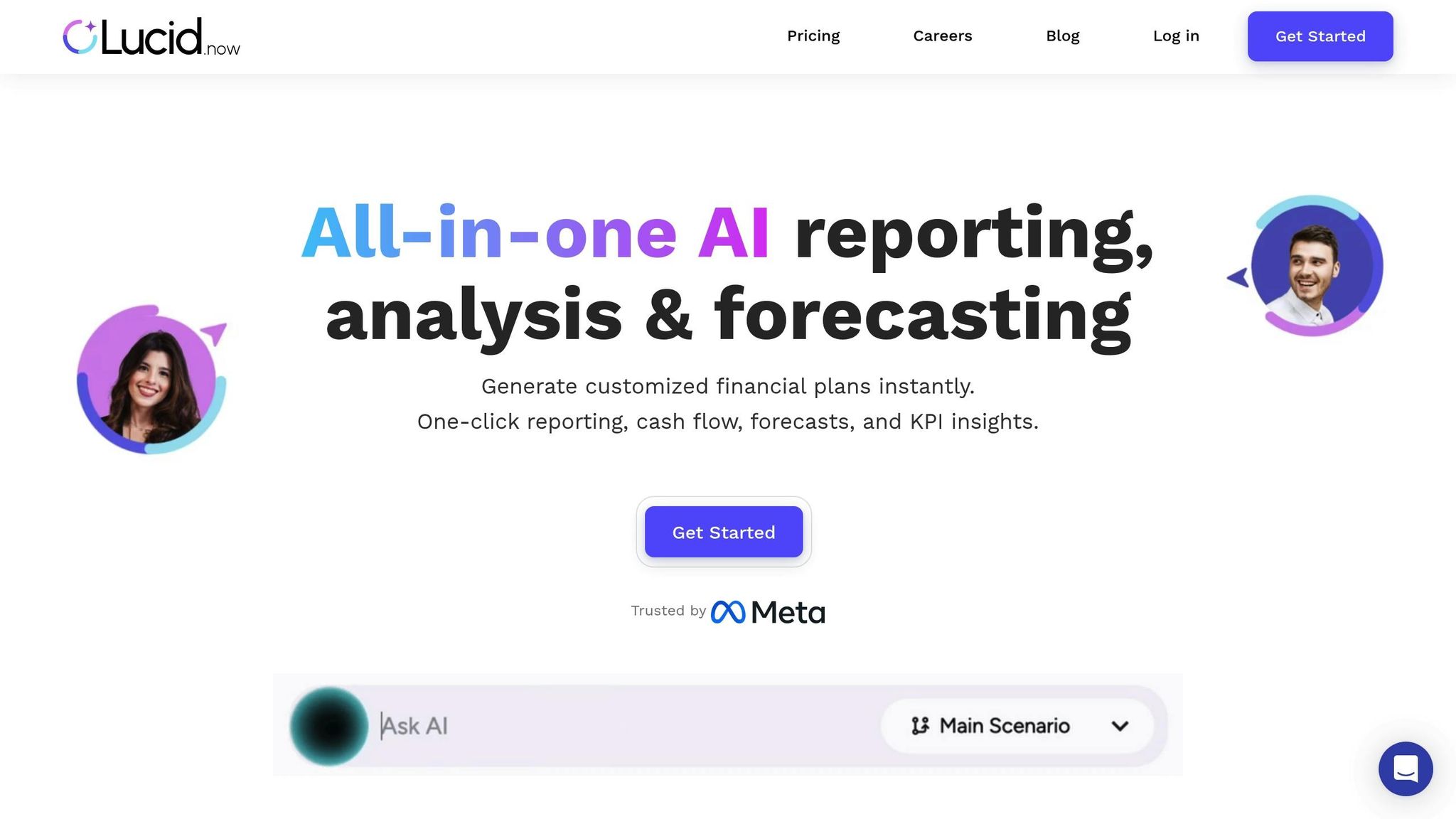Want to make smarter decisions for your startup? Scenario modeling helps you prepare for uncertainty by creating financial plans for different outcomes. Here's how it works:
- Base Case: Your most likely financial projection based on current trends.
- Best Case: An optimistic yet realistic growth scenario.
- Worst Case: A cautious projection that accounts for potential setbacks.
Why use data-driven planning?
It ensures your scenarios are built on real metrics like customer acquisition costs, churn rates, and market trends - not guesswork. Tools like Lucid Financials automate this process, making it easier to compare scenarios and adjust strategies in real time.
Key benefits:
- Allocate resources wisely by understanding how investments impact growth.
- Extend your cash runway by spotting opportunities to boost cash flow.
- Confidently plan hiring and operations while minimizing risks.
Quick tip: Use both internal data (like financial statements) and external sources (like industry benchmarks) for accurate projections. Avoid common mistakes like outdated data or selection bias.
With tools like Lucid Financials, you can automate scenario modeling, compare outcomes side by side, and turn insights into actionable strategies for funding, hiring, and scaling.
Start today: Build your base, best, and worst-case scenarios, track performance, and update your projections regularly to stay ahead.
Core Elements of Data-Driven Assumptions
Understanding Data-Driven Assumptions
Data-driven assumptions are built on measurable metrics and historical trends, steering clear of guesswork. These assumptions help create reliable scenario models by factoring in:
- Historical performance: Metrics like customer acquisition costs, churn rates, and revenue growth provide a clear track record.
- Market indicators: Data from industry benchmarks, economic trends, and the competitive landscape.
- Customer behavior: Insights from usage patterns, purchasing cycles, and engagement metrics.
For accurate assumptions, pull real-time inputs using tools like Lucid Financials. Combine these with data from dependable internal and external sources.
Finding Quality Data Sources
Internal Data Sources
Tap into your organization’s existing resources, such as:
- Financial statements and accounting records.
- Sales pipeline and CRM data.
- Customer support tickets and feedback.
- Product usage analytics.
- Employee productivity metrics.
External Data Sources
Look beyond your company for insights, including:
- Industry reports and market research.
- Economic indicators.
- Competitor analysis.
- Customer surveys and interviews.
- Social media analytics.
Once you’ve gathered your data, ensure accuracy by avoiding common mistakes.
Common Mistakes to Avoid
Even with the right data sources, errors can undermine your models. Here are key pitfalls to watch out for:
- Data Inconsistency: Mixing periods, formats, or units without standardizing can lead to flawed conclusions. Always normalize your data.
- Selection Bias: Avoid cherry-picking data that supports a specific narrative. Consider outliers and avoid overemphasizing short-term trends.
- Outdated Information: Using old or unvalidated data can skew results. Update your inputs regularly and account for market changes.
Tools like Lucid Financials can help with automated validation and real-time updates, ensuring your assumptions stay accurate and relevant.
How to Show Upside, Base Case, and Downside Scenarios in ...
Building Your Scenario Model
Once you have accurate, consistent data, it's time to define your model's structure and key metrics.
Setting Key Performance Metrics
Start by identifying the metrics that will drive your model, based on your data-backed assumptions. Focus on the most important KPI first. For example, Customer Acquisition Cost (CAC) is a useful metric to measure how much you spend to gain a new customer. Ensure this aligns with your growth goals and available cash. To avoid confusion, make sure these metrics are consistent across all scenarios.
Creating Multiple Scenarios
Develop three distinct scenarios: Base, Optimistic, and Conservative. Stick to the templates outlined earlier for consistency and clarity.
Comparing Scenarios
Compare revenue, costs, and cash flow side by side across your scenarios. This analysis helps you see how changes in metrics affect your overall strategy. It also highlights which scenario aligns best with your goals. Tools like Lucid Financials can simplify and automate these comparisons, saving time and reducing manual effort.
sbb-itb-17e8ec9
Using Lucid Financials for Scenarios

With your scenario framework ready, Lucid Financials helps streamline and automate your planning process.
Automated Scenario Planning
Lucid Financials integrates with tools like QuickBooks and payroll systems to pull in actual data on CAC, churn, and cash flow. This allows you to create plans instantly using real-time metrics and benchmarks. You can tweak key variables across scenarios to ensure consistent, side-by-side comparisons. By automating these tasks, startups can save time and focus on making agile decisions.
Tools for Startup Planning
- Real-time Dashboard: Get instant insights into cash flow and key performance indicators (KPIs).
- Scenario Comparison: Analyze multiple scenarios side by side to guide growth strategies.
- Industry Benchmarks: Set realistic goals by comparing against peer data.
- Team Planning: Estimate hiring costs and timelines with ease.
Scenario Modeling Example
Abilisense Founder Erez Lugashi shared:
"Keeping track of my finances used to be overwhelming, but now it's much simpler. The platform is easy to navigate."
With Lucid Financials, scenarios automatically update as new data comes in, offering real-time insights into how decisions impact your finances. The Professional plan allows for unlimited scenarios, enabling startups to explore a variety of market conditions, growth strategies, and operational changes. This approach equips businesses to make smarter choices while keeping their finances on track.
Using Results for Business Decisions
Turn your scenario comparisons into actionable business strategies by leveraging the insights gained from your models.
Evaluating Risks and Opportunities
Look at the best-case, worst-case, and baseline scenarios to identify key factors like:
- Burn rate: Keep an eye on monthly cash outflows to spot areas where spending might be too high.
- Growth trajectory: Project revenue and market expansion to assess future potential.
Pay attention to cash flow signals to plan the right time for fundraising or to adjust spending priorities.
Presenting Insights to Stakeholders
When sharing findings with stakeholders, follow this structure:
- Flow: Start with a snapshot of the current situation, move into scenario comparisons, and finish with clear recommendations.
- Key metrics: Highlight revenue forecasts, burn rate, runway duration, and risk indicators.
- Visual aids: Use side-by-side charts to compare cash flow trends and growth projections for clarity.
Turning Insights into Action
Use real-time scenario data to guide decisions on funding, hiring, and scaling. Pinpoint the best times to bring on new team members, tweak spending to stretch your runway, and choose the most promising growth strategy. Tools like Lucid Financials' dashboards can help you put these decisions into practice seamlessly.
Conclusion
Key Takeaways
Using data-driven scenario modeling helps startups tackle uncertainty and plan for growth more effectively. By working with real-time data, startups can better match their resources to their growth goals.
Here are some of the main benefits:
- Faster decisions: Real-time insights make it easier to make informed choices about funding, hiring, and scaling efforts.
- Managing risks: Comparing different scenarios helps spot potential challenges early.
- Improved growth planning: Analyzing various growth paths allows for smarter strategic decisions.
How to Begin
- Identify your baseline metrics.
- Create conservative, moderate, and aggressive scenarios.
- Regularly track actual performance and update your projections.
Start exploring scenario modeling with Lucid Financials today to make confident decisions in uncertain times.


